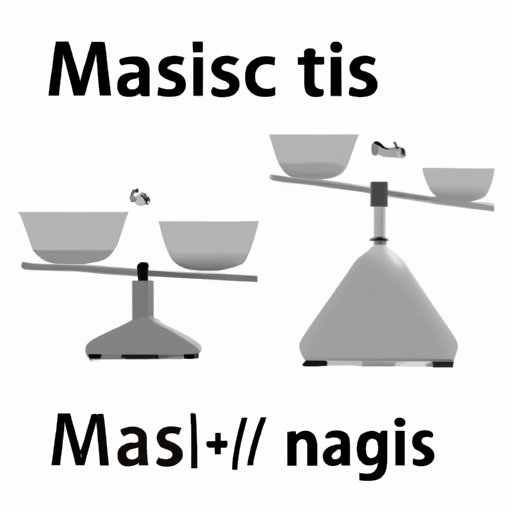
Introduction
Have you ever wondered how to find mass from weight? Or perhaps you’ve been confused about the difference between these two concepts and why it matters? Understanding the relationship between mass and weight is crucial, especially for those in fields such as manufacturing, engineering, or medicine. In this article, we will explore the difference between mass and weight, the formula for finding mass from weight, and real-world applications of this concept.
Understanding Mass and Weight
Before diving into how to find mass from weight, it’s essential to understand what mass and weight are and the difference between them. Mass is the amount of matter in an object and is typically measured in kilograms (kg) or grams (g). Weight, on the other hand, is the force of gravity acting on an object and is measured in Newtons (N) or pounds (lbs).
The key difference between mass and weight is that mass remains constant, whereas weight can vary depending on the gravitational force acting upon an object. For example, an object with a mass of 10 kg will have the same mass regardless of where it is in the universe. However, its weight will differ if it is on Earth compared to the Moon or Mars.
Understanding the difference between mass and weight is vital since it can impact measurements and calculations in various fields. For example, in medicine, knowing a patient’s weight versus their mass can impact the dosage of medication given.
Formula for Finding Mass from Weight
Finding mass from weight involves using a straightforward formula that involves the gravitational acceleration (g), weight (W), and mass (m). The formula is as follows:
m = W/g
Where m represents mass, W represents weight, and g represents gravitational acceleration (9.81 m/s^2 on Earth).
To use the formula, you will need to know the weight of the object in question. For example, if you have a box that weighs 50N, and you want to find its mass, you would plug in the variables as follows:
m = 50N/9.81 m/s^2
m = 5.1 kg
Therefore, the box has a mass of 5.1 kg.
Examples of Finding Mass from Weight
Let’s look at some simple examples to illustrate the process of finding mass from weight.
Example 1: You have a book that weighs 10N. Find its mass.
m = 10N/9.81 m/s^2
m = 1.02 kg
Therefore, the book has a mass of 1.02 kg.
Example 2: You have a suitcase that weighs 150lbs. Find its mass.
m = 150lbs/(32.2 ft/s^2 x 0.3048 m/ft)
m = 68.04 kg
Therefore, the suitcase has a mass of 68.04 kg.
These examples demonstrate that the formula for finding mass from weight is simple and straightforward to use. However, it’s essential to note that the units of measurement must be consistent when using the formula.
Measuring Mass and Weight
To find mass from weight, we need to know the weight of the object. Therefore, understanding tools and equipment used to measure weight is crucial. One of the most common tools used to measure weight is a scale. Scales can vary in size and capacity, from small kitchen scales to large industrial scales capable of weighing thousands of pounds.
The accuracy of a scale can depend on various factors, such as its calibration, location, and even temperature. Therefore, it’s essential to ensure that the scale you use is calibrated correctly and that you take measurements under controlled conditions. Additionally, instruments such as load cells and force gauges can be used to measure weight.
In contrast, measuring mass can be done using tools such as a balance or mass scale. These instruments work by comparing the mass of an object to a reference mass, often using a counterweight system.
Real-World Applications of Finding Mass from Weight
Finding mass from weight has practical applications in various fields. For example, in manufacturing, knowing the mass of materials used in a product can impact the quality and safety of the final product. In the aerospace industry, understanding the relationship between mass and weight is vital for designing and testing aircraft and spacecraft.
In medicine, measuring weight is often used to determine an individual’s body mass index (BMI). However, this is not always accurate since weight can be influenced by factors such as muscle mass and water weight. Therefore, knowing an individual’s mass can provide a more accurate representation of their body composition.
Troubleshooting Common Mistakes and Obstacles
One common mistake people make when finding mass from weight is not understanding the difference between the two concepts. Remembering that mass is the amount of matter in an object, whereas weight is the force of gravity acting on an object, can prevent confusion when using the formula.
Another common challenge is ensuring that units of measurement are consistent. Remember that the formula requires weight to be measured in Newtons (N) and mass in kilograms (kg).
Additional Resources
If you’re interested in learning more about mass, weight, and related topics, there are various physics textbooks and online resources available. Some recommended books include “Fundamentals of Physics” by Halliday, Resnick, and Walker and “University Physics” by Young and Freedman. Additionally, online resources such as Khan Academy offer free physics tutorials and videos.
Conclusion
In conclusion, understanding the difference between mass and weight and how to find mass from weight is crucial in various fields. The formula for finding mass from weight is simple to use but requires consistency in units of measurement. The practical applications of this concept range from manufacturing to medicine and other industries in between. Knowing how to find mass from weight can lead to more accurate measurements and better-designed products.




